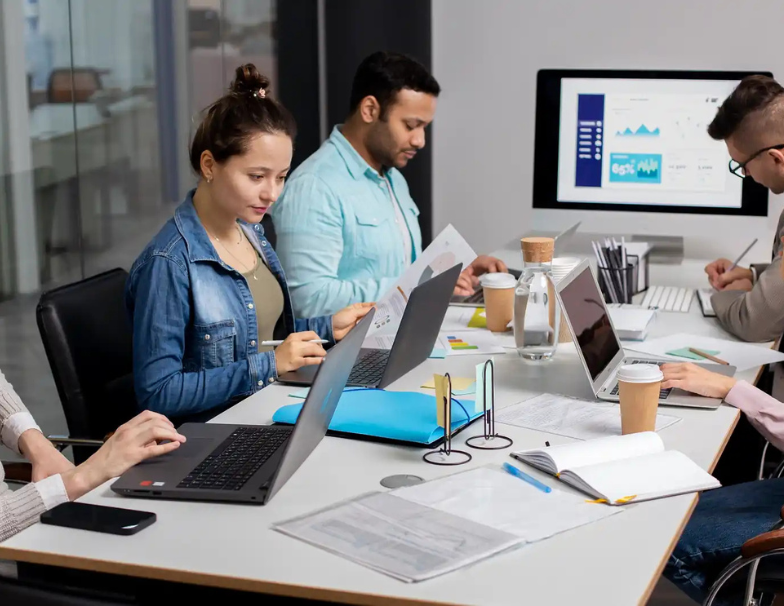50 Best Work Retreat Ideas to Energize and Unite Your Team

Looking for the best ways to energize your team? Work retreats can help. This guide covers 50 top work retreat ideas, their benefits, and tips for planning a successful retreat.
Key Takeaways
- Work retreats foster team cohesion and enhance employee morale through shared experiences and activities that promote trust and collaboration.
- Careful planning, including setting clear objectives and selecting the ideal location, is crucial for a successful work retreat that strikes a balance between work and leisure.
- Incorporating technology and innovative activities, such as virtual escape rooms and wellness sessions, can enhance engagement and make retreats memorable for teams.
The Value of Work Retreats

Company retreats are more than just a getaway; they are a strategic investment in your team’s cohesion and overall performance. Retreats foster deeper relationships among employees, building trust, empathy, and respect within the workplace. Sharing a meal or engaging in team building activities during these retreats helps foster a deeper understanding of teammates and strengthens existing bonds.
The primary purpose of corporate retreats is to rejuvenate the team’s mindset and build strong relationships that translate into measurable business value. These retreats offer a blend of fun and team building activities, fostering a relaxed environment that encourages open communication and collaboration. The result? Higher morale, renewed energy, and improved team performance.
Moreover, retreats foster personal connections, particularly for remote teams, thereby boosting overall morale and productivity. Activities like fishing, outdoor adventures, or even casual social events foster camaraderie and team bonding, which are essential for a healthy company culture.
Planning Your Work Retreat

Planning a company retreat involves a thoughtful blend of creativity and logistics. Key considerations include:
- Identifying your company objectives
- Choosing an appropriate destination
- Mixing work and leisure activities to create a well-rounded retreat experience
- Observing team dynamics to reveal leadership potential and align objectives
Careful planning ensures that everyone has a successful and memorable experience.
Defining Objectives
Setting clear objectives is the cornerstone of a successful company retreat. Goals and KPIs should be defined early on to evaluate the retreat’s effectiveness. These objectives might address specific challenges, such as enhancing communication or fostering creativity within the team. Establishing a sense of purpose ensures that every activity and discussion during the retreat contributes to these goals.
Measurable retreat goals that align with broader company objectives are critical elements of a successful company retreat, ensuring the planning process is both focused and effective. This approach facilitates the evaluation of impact and enables informed decision-making for future retreats. Clear objectives guide the planning process, striking a balance between problem-solving and team building activities.
Choosing the Right Location
The location of your company retreat plays a critical role in its success. When selecting a venue, consider the following:
- Choose a location that aligns with the team’s vibe and retreat objectives to foster engagement and collaboration.
- Ensure the chosen location resonates with your team, enhancing the overall retreat experience.
- Decide between options, such as a serene mountain lodge or a bustling city center, based on what best reflects the retreat’s goals.
- Consider the company’s budget constraints when selecting a location.
Planning involves considering logistics, such as smooth transportation and diverse catering options. The timing of the retreat is equally important; you need to factor in team schedules, weather conditions, and travel costs to select the best possible venue.
A well-chosen location significantly enhances the effectiveness of your company retreat, making a positive impact that participants will remember.
Balancing Activities and Free Time
A successful company retreat strikes a balance between structured activities and free time. The retreat agenda should include:
- Downtime for relaxation and unstructured interactions to foster organic connections and memorable experiences
- Meaningful work time
- Varied activities
- Ample free time to ensure engagement and relaxation
Wellness activities, such as yoga or meditation, help manage stress and promote emotional well-being among team members. Consider inclusivity and flexibility in your retreat activities, encouraging participation without making it mandatory. This balance ensures that all team members can enjoy and benefit from the retreat experience.
Creative Work Retreat Ideas
Infusing creativity into your company retreat can foster innovative thinking and problem-solving within your team. From outdoor adventure activities to indoor team building exercises and cultural explorations, there are numerous new ideas for company retreats to choose from.
These activities not only promote team bonding but also create a fun and engaging retreat experience that everyone will remember. The team’s efforts in organizing these activities ensure a memorable time for all.
Outdoor Adventure Activities
Outdoor adventure activities are an excellent way to foster teamwork and rejuvenation among team members. Activities like:
- kayaking
- hiking
- zip-lining
- Biking helps teams bond while connecting with nature, leading to improved morale and collaboration. These adventures provide a welcome break from the usual work environment, enabling team members to unwind and foster stronger relationships.
Additionally, fun options such as laser tag or skiing can provide opportunities for healthy competition and team engagement. Whether it’s a scavenger hunt in a local park or a team sports event, these activities offer a fresh air experience that can help team members recharge and return to work with renewed energy.
Indoor Team Building Exercises
Indoor team building exercises are perfect for fostering collaboration and problem-solving skills among team members. Virtual escape rooms, for instance, require participants to work together to solve challenges, enhancing teamwork and communication. These activities are especially beneficial for remote teams, as they foster collaboration and improve problem-solving skills in a fun and engaging manner.
Cooking classes are another excellent indoor activity that promotes team bonding. These classes allow team members to learn new culinary skills together, fostering collaboration and creativity. Whether it’s a themed cooking class or a casual board game night, indoor team building exercises offer opportunities for team members to connect and collaborate in a relaxed setting.
Cultural Exploration and City Tours
Cultural exploration activities, such as city tours and museum visits, offer a unique way for teams to bond while broadening their perspectives. Participating in city tours during retreats allows team members to get to know the local culture and history, enhancing their overall retreat experience each day and across the days. People can genuinely benefit from these enriching experiences related to cultural exploration and share in the joy of discovery.
These activities provide a relaxed yet engaging environment for team bonding and working learning.
Virtual Work Retreat Ideas

For remote teams, virtual work retreat ideas can be just as practical in fostering team bonding and collaboration. Utilizing technology, you can create engaging and interactive retreat experiences that cater to the unique dynamics of remote teams.
Virtual escape rooms, online cooking classes, and virtual wellness sessions are excellent options for bringing your team together, regardless of their location.
Virtual Escape Rooms
Virtual escape rooms are an exciting way to spark creativity and teamwork among remote teams. These activities are designed to enhance collaboration as team members work together to solve puzzles and challenges. An escape room is flexible, accommodating groups of varying sizes and making them suitable for teams spread across different locations.
Virtual escape rooms strengthen team dynamics and promote a sense of unity, even when team members are physically apart. These engaging activities help remote teams think creatively and work together towards a common goal.
Online Cooking Classes
Online cooking classes offer a fun and innovative way for remote teams to connect and collaborate. These classes cater to diverse dietary preferences, ensuring that all team members can participate and enjoy the experience. As team members prepare meals together, they bond over shared culinary adventures, fostering a sense of camaraderie and teamwork.
Participating in cooking classes enables team members to acquire new skills and boost their confidence in their abilities. These classes can be themed to reflect team interests, keeping participants engaged and excited throughout the experience.
Virtual Wellness Sessions
Incorporating wellness activities into virtual retreats can significantly benefit remote teams. Activities such as:
- Yoga
- Meditation
- Mindfulness talks help manage stress and promote emotional well-being among team members. These sessions can be structured to accommodate different fitness levels, ensuring that everyone can participate and benefit from the experience.
Virtual wellness sessions offer a chance for team members to recharge and reconnect with themselves and their colleagues. By prioritizing wellness, you can create a positive and supportive retreat environment that enhances overall team morale and productivity.
Enhancing Work Retreats with Technology

Leveraging technology can significantly enhance the overall experience of work retreats. From using apps for organization to incorporating graphic recording and virtual reality, technology offers innovative ways to engage participants and streamline the retreat planning process.
These tools can help create a more interactive and memorable retreat experience, offering a unique way to engage participants.
Using Apps for Organization
Event planning apps can streamline the logistics of organizing a company retreat. Apps like Retreat Guru could consolidate logistics and booking management, making the planning process more efficient and less stressful.
These apps ensure that all details are handled smoothly, allowing you to focus on creating meaningful retreat experiences for your team.
Graphic Recording for Engagement
Graphic recording is a powerful tool for enhancing engagement during corporate retreats. By visually capturing conversations in real-time using illustrations and text, graphic recording makes discussions more engaging and memorable. This technique helps participants visualize and retain information better, contributing to a more impactful retreat experience.
Creating visual records of discussions can also foster better communication and idea sharing among team members. Overall, graphic recording enhances the effectiveness and impact of corporate retreats, making them more engaging and enjoyable for participants.
Virtual Reality Experiences
Incorporating virtual reality experiences into your retreats can provide immersive and unique team building activities. VR offers a shared, immersive experience that facilitates team bonding and engagement, regardless of physical location. These activities can include virtual escape rooms or other collaborative games that enhance teamwork and collaboration.
Virtual reality experiences are accessible from anywhere, making them ideal for remote teams seeking to engage in interactive and memorable activities. By integrating VR into your retreat, you can create a dynamic and engaging environment that fosters team unity and creativity.
Measuring the Success of Your Work Retreat
Measuring the success of your company retreat is crucial for evaluating its effectiveness and planning future events. By assessing various metrics, such as employee engagement, productivity, and satisfaction, you can determine the retreat’s impact on team dynamics and overall performance.
This evaluation helps identify areas for improvement and ensures that future retreats are even more successful.
Post-Retreat Surveys
Conducting post-retreat surveys is a key step in gathering feedback from participants. These surveys should be customized to cover various aspects of the retreat, including logistics, content, and overall satisfaction. Effective surveys should include both quantitative and qualitative questions to gather comprehensive feedback.
Gauging attendees’ perceptions and the short-term effects of the retreat through these surveys helps in understanding the immediate impact of the experience. This feedback can inform future retreat planning and ensure that activities and logistics cater to everyone’s preferences.
Analyzing Team Dynamics
Analyzing team dynamics after the retreat is crucial for understanding the long-term impact on team cohesion and collaboration. Observing changes in team interactions and openness to collaboration can provide valuable insights into the improvements made during the retreat. These behavioral changes are indicators of how well the retreat objectives were met and can guide future planning.
Long-term assessments should also monitor key metrics, such as employee engagement and retention, to evaluate the sustained impact of the retreat. By monitoring these metrics, you can ensure that the positive effects of the retreat continue to benefit both the team and the company culture.
Setting Future Goals
Setting actionable goals based on retreat feedback is a great way to enhance future events. Insights gained from participant feedback can help establish specific and measurable objectives for subsequent retreats. These goals should focus on addressing any identified issues and building on the successes of the previous retreat.
Utilizing these insights ensures that future retreats are better tailored to meet the team’s needs and objectives. By continuously refining your retreat planning process, you can create more effective and engaging experiences that drive team performance and satisfaction.
Summary
In summary, company retreats are a powerful tool for fostering team bonding, enhancing communication, and boosting overall morale. Proper planning, including defining clear objectives, selecting the ideal location, and striking a balance between activities and downtime, is essential for a successful retreat. Creative retreat ideas, such as outdoor adventures, indoor team building exercises, and cultural exploration, can make the experience memorable and impactful. Companies like Offsite can streamline the entire process by providing expert planning, curated experiences, and logistical support tailored to each team’s unique goals.
Leveraging technology can further enhance the retreat experience, making it more interactive and engaging. Measuring the success of your retreat through post-retreat surveys and analyzing team dynamics helps in refining future events. By setting actionable goals based on feedback, you can ensure that your retreats continue to drive positive outcomes for your team and company culture.
FAQs
- Why are work retreats important?
Work retreats are crucial as they foster trust and empathy among employees, leading to improved team performance and enhanced business value. Investing in such experiences can significantly strengthen team dynamics.
- How should I plan a successful company retreat?
To plan a successful company retreat, establish clear objectives, select a location that aligns with your team's vibe, and ensure a balance of structured activities and downtime for relaxation and bonding. This approach will foster engagement and productivity.
- What are some creative ideas for work retreats?
Creative work retreat ideas include outdoor adventure activities, team building exercises like escape rooms, and cultural explorations such as city tours, all of which foster collaboration and engagement. Choose options that resonate with your team's interests for maximum impact.
- How can technology enhance work retreats?
Technology can significantly enhance work retreats by utilizing apps for organization, incorporating graphic recording for visual engagement, and leveraging virtual reality to create interactive experiences. This approach fosters collaboration and keeps participants actively involved.
You may also like
Unique spaces for your next offsite
Find distinctive venues for your upcoming corporate retreat.
Stay Updated with Our Insights
Get exclusive content and valuable updates directly to you.







